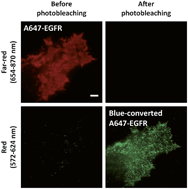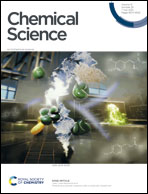Blue-conversion of organic dyes produces artifacts in multicolor fluorescence imaging†
Abstract
Multicolor fluorescence imaging is a powerful tool visualizing the spatiotemporal relationship among biomolecules. Here, we report that commonly employed organic dyes exhibit a blue-conversion phenomenon, which can produce severe multicolor image artifacts leading to false-positive colocalization by invading predefined spectral windows, as demonstrated in the case study using EGFR and Tensin2. These multicolor image artifacts become much critical in localization-based superresolution microscopy as the blue-converted dyes are photoactivatable. We provide a practical guideline for the use of organic dyes for multicolor imaging to prevent artifacts derived by blue-conversion.

- This article is part of the themed collection: 2021 Chemical Science HOT Article Collection


 Please wait while we load your content...
Please wait while we load your content...